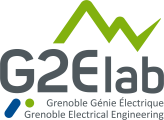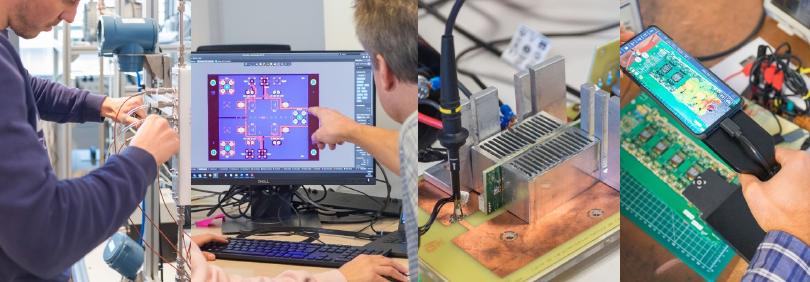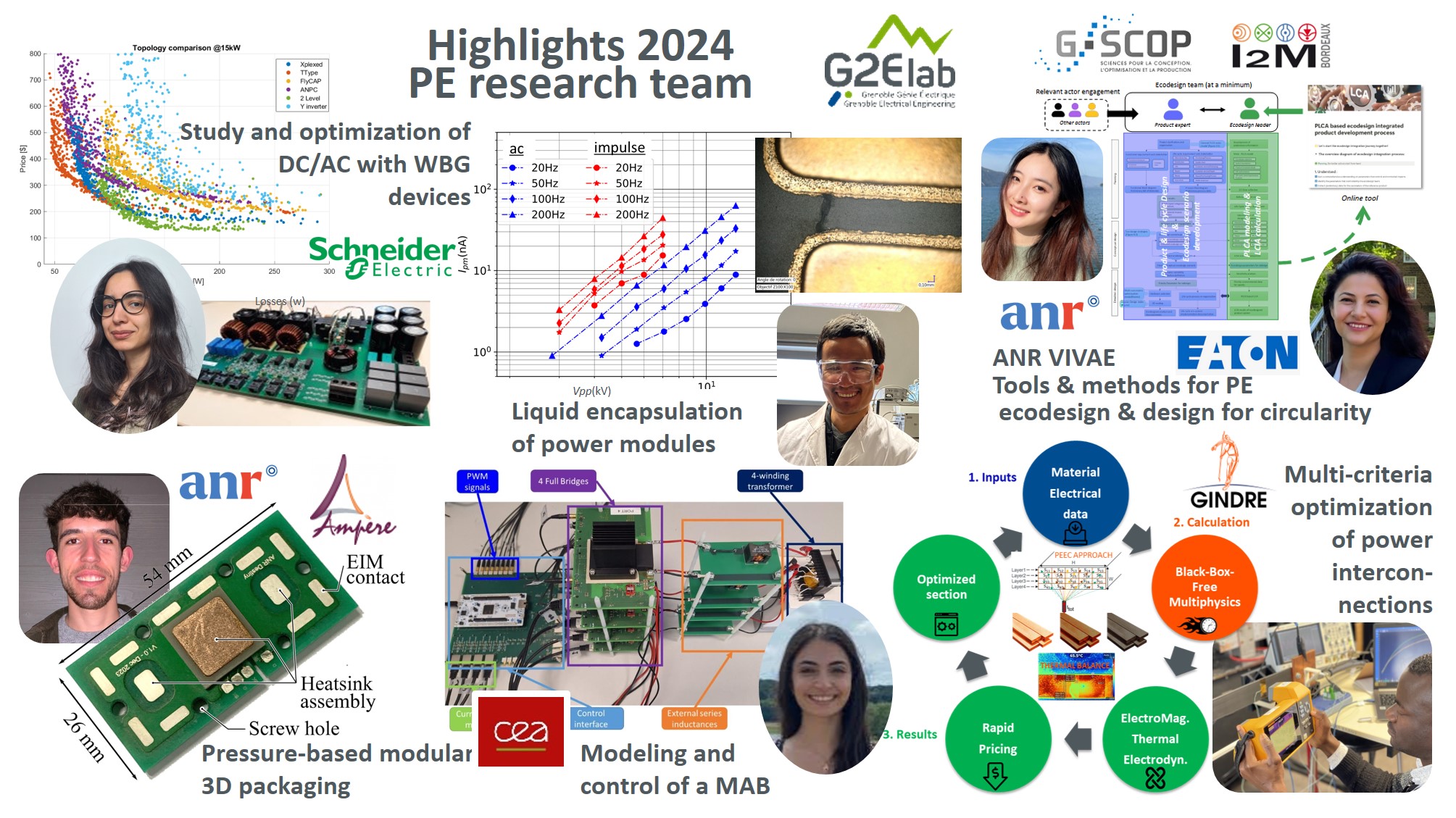Comparative analysis of multi-level inverter topologies utilizing WBG components
This work investigates the performance of 2-Level and 3-Level DC/AC inverter topologies utilizing wide band gap semiconductors. A highly precise design optimization methodology is used to derive the optimal performance in terms of price, loss, and volume, based on a large-scale database of commercially available components to guide design engineers in choosing the suitable topology at various power levels.
Involved persons: Involved persons in this research activity are Meriem Ouzouigh (PhD candidate), Timothé Delaforge (Prof BFH), Jean-Luc Schanen(Prof UGA), Alain Lacarnoy (Expert Schneider Electric)
Liquid encapsulation: performance under stress for wide bandgap power semiconductor modules
This study investigates dielectric liquids as alternatives to silicone gel for encapsulating power modules in extreme conditions (T > 250°C, fast rising impulse voltage). Electrical properties (conductivity, permittivity, breakdown voltage, partial discharge initiation) were characterized with submerged substrates to evaluate the voltage and temperature limits of liquid/substrate systems, mimicking the conditions in wide bandgap semiconductor modules.
Involved persons: Involved persons in this research activity are: Chencho DORJI (PhD candidate), Olivier LESAINT (DR CNRS), Rachelle HANNA (MdC, Grenoble INP).
Life cycle assessment method for power electronics : application to a buck converter
During VIVAE project, tools, methods and metrics for eco-design and design for circularity have been developed. En partnership with EATON company, two main contributions have been produced. First a Parametric LCA method that can be used, prior manufacture stage, to support power electronics designer with new opportunities to reduce environmental impacts. Second, a decision tree and a residual value indicator to guide choice at the end of usage of PE converters or even to support design choices to increase power converter circularity.
Involved persons: This work was conducted as part of the ANR-funded VIVAE project. It involved Tugce TURKBAY (PhD candidate) and Li FANG (PhD candidate), Pierre LEFRANC (Associate Prof. G-INP), Maud RIO (Associate Prof. UGA), Benoît SARRAZIN (IR G-INP), Yannis ROSSET (Engineer G-INP) Thècle ALIX (Associate prof. Arts et Métiers Bordeaux), Yves LEMBEYE (PR UGA), Julien MELOT (Engineer EATON), Nicolas PERRY (PR Arts et Métiers Bordeaux) and Jean-Christophe Christophe CREBIER (DR CNRS)
New modular 3D packaging concept based on pressure assembly with compressed metal foam
New 3D packaging concept for 1.2kV SiC MOSFET chips based on the use of single-chip pre-packages with cooling and double-sided insulation. The pre-packages are assembled using motherboards and metal foams compressed by an external pressure system. Switching cell parasitic inductance is close to 2.5 nH. Modularity and disaseembly are considered to a greater extent than with conventional technologies.
Involved persons: Paul Bruyere (PhD), Yvan Avenas (Pr G-INP) and Eric Vagnon (MdC ECL) funded by the Pack-Ambition Recherche TAPIR and ANR DESTINI (ANR-21-CE05-0037) projects
Modeling and Optimal Control of a Multi-Active Bridge (MAB) Converter
The « Energy Routers » which allow to interconnect multiple sources, loads, storages and networks together experience a high interest. The use of Multi Active Bridge systems allos to optimize the Hardware architecture and offers a high number of control possibilities. However, this necessitates to optimize the operating points to enhance the efficiency. The originality of this work is that it does not any assumption concerning the operating points but uses a real time optimizing algorithm embedded in the control in order to determine the optimal settings.
Involved persons: Rebeca Tarraf (PhD candidate) and David Frey (Assistant Professor)
Optimization of power interconnections under electromagnetic and thermal constraints
The massive electrification of domestic and industrial applications is leading to the stressing of materials such as copper, which is widely used for electrical connections in systems. Its cost has increased from €1.5/kg in 2020 to €10/kg by 2022, minimizing the quantity used to the detriment of joule losses incurred by the operator. Minimizing joule losses due to frequency in conductors has been well studied, but consideration of thermal constraints, particularly in enclosed spaces, has never been integrated into the design process.
Involved persons: G2Elab, with its experience in modeling interconnections, has partnered with the company Gindre-Duchavany, which has been involved in the transformation of infinitely recyclable copper since 1823, for the innovative design of electrical connections. Involved persons at G2Elab : A. Dantondgi, E. Clavel, J. Roudet



